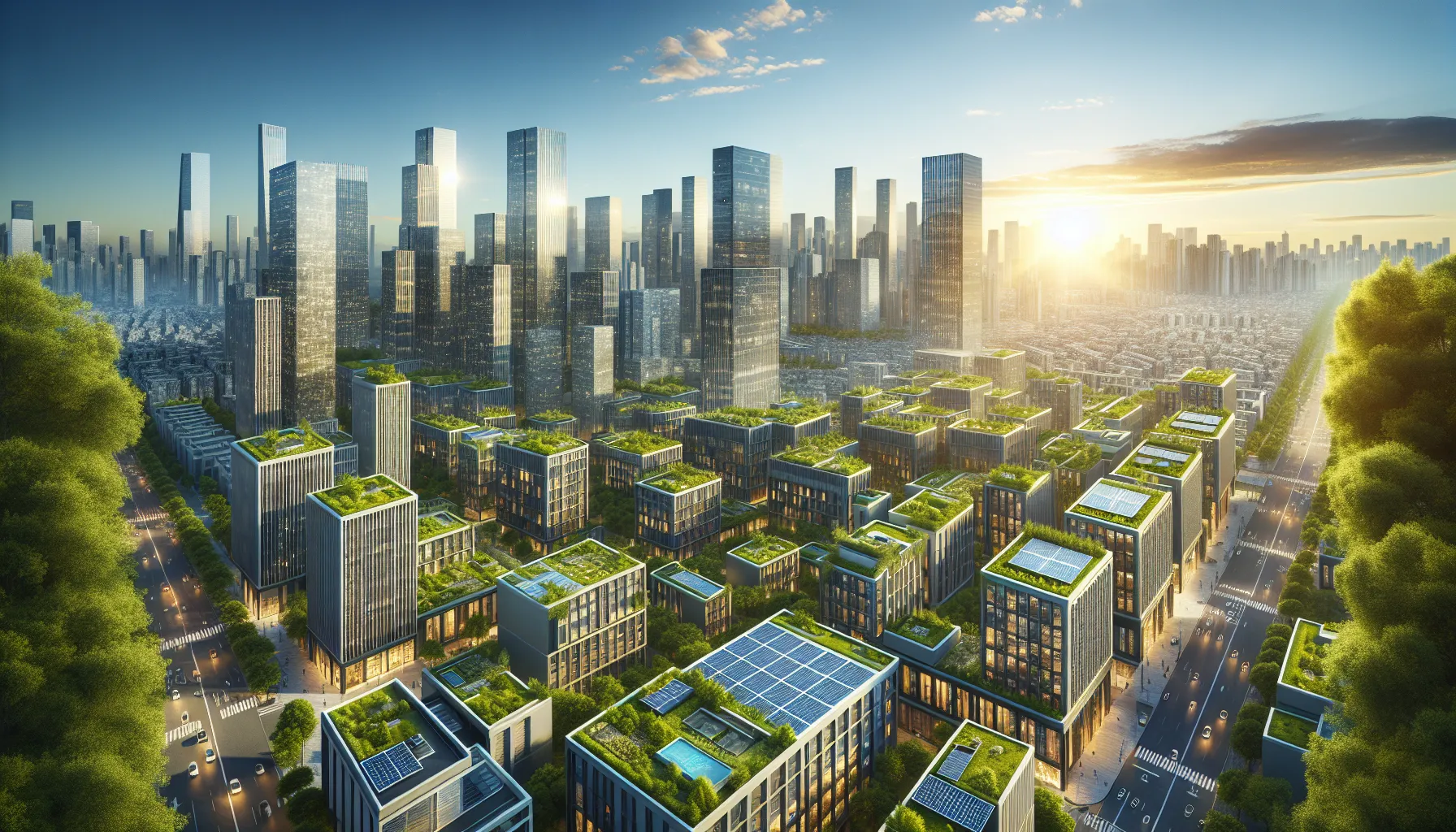In recent years, the IELTS Reading test has increasingly featured passages on contemporary topics such as sustainable development and environmental conservation. One such topic that has gained significant attention is “The rise of eco-friendly architecture in modern construction.” As an experienced IELTS instructor, I’m excited to share with you a comprehensive practice test that explores this fascinating subject while helping you hone your reading skills for the IELTS exam.
 Eco-friendly architecture concept
Eco-friendly architecture concept
IELTS Reading Practice Test: The Rise of Eco-Friendly Architecture
Passage 1 (Easy Text)
Green Building: A New Era in Construction
The construction industry is undergoing a paradigm shift towards sustainability. Eco-friendly architecture, also known as green building, is rapidly gaining popularity worldwide. This approach to design and construction aims to minimize the negative impact of buildings on the environment while maximizing their positive effects on human health and well-being.
Green buildings incorporate various features that make them environmentally responsible and resource-efficient throughout their lifecycle. These features include energy-efficient systems, water conservation techniques, and the use of sustainable materials. For instance, many green buildings utilize solar panels to generate clean energy, reducing their reliance on fossil fuels.
One of the key aspects of eco-friendly architecture is the concept of biophilic design. This approach seeks to connect building occupants more closely with nature by incorporating natural elements into the built environment. Examples include living walls, indoor gardens, and the use of natural lighting and ventilation systems.
The benefits of green buildings extend beyond environmental conservation. Studies have shown that occupants of green buildings often experience improved health, productivity, and overall satisfaction. Moreover, green buildings can lead to significant cost savings over time through reduced energy consumption and lower maintenance requirements.
As awareness of climate change and environmental issues continues to grow, the demand for eco-friendly architecture is expected to increase. Governments and organizations around the world are implementing policies and incentives to encourage the adoption of green building practices. This trend is likely to shape the future of the construction industry, leading to more sustainable and resilient urban environments.
Questions 1-5
Do the following statements agree with the information given in the passage?
Write
TRUE if the statement agrees with the information
FALSE if the statement contradicts the information
NOT GIVEN if there is no information on this
- Eco-friendly architecture aims to reduce the negative impact of buildings on the environment.
- Green buildings always cost more to construct than traditional buildings.
- Biophilic design incorporates natural elements into buildings.
- Occupants of green buildings report lower levels of job satisfaction.
- Governments worldwide are discouraging the adoption of green building practices.
Questions 6-10
Complete the sentences below.
Choose NO MORE THAN TWO WORDS from the passage for each answer.
- Green buildings use to generate clean energy.
- The of green buildings often experience improved health and productivity.
- Eco-friendly architecture can lead to cost savings through reduced and lower maintenance needs.
- The concept of aims to connect building occupants more closely with nature.
- The rise of eco-friendly architecture is expected to create more and urban environments.
Passage 2 (Medium Text)
Innovative Technologies in Sustainable Architecture
The burgeoning field of eco-friendly architecture is being propelled forward by a range of cutting-edge technologies. These innovations are not only making buildings more environmentally friendly but are also revolutionizing the way we think about the built environment and its relationship with nature.
One of the most promising technologies in sustainable architecture is the development of smart building systems. These integrated networks of sensors and controls optimize a building’s performance by managing energy use, lighting, heating, and cooling in real-time. For example, smart windows can automatically adjust their tint based on sunlight intensity, reducing the need for artificial cooling and lighting.
Another area of innovation is in advanced materials science. Researchers are developing new materials that are not only more sustainable but also possess enhanced properties. For instance, photocatalytic concrete can break down air pollutants when exposed to sunlight, effectively cleaning the air around the building. Similarly, phase-change materials can absorb and release heat, helping to regulate indoor temperatures without the need for energy-intensive HVAC systems.
The concept of biomimicry is also gaining traction in eco-friendly architecture. This approach involves emulating nature’s time-tested patterns and strategies to solve human design challenges. For example, the Eastgate Centre in Harare, Zimbabwe, mimics the self-cooling mounds of African termites to create a building that maintains a comfortable temperature without conventional air conditioning.
Renewable energy technologies continue to play a crucial role in sustainable architecture. Beyond traditional solar panels, innovative solutions like building-integrated photovoltaics (BIPV) are emerging. These systems integrate solar cells directly into building materials, such as windows or roofing tiles, allowing structures to generate clean energy without compromising aesthetics.
Water management is another critical aspect of eco-friendly architecture. Advanced systems for rainwater harvesting, greywater recycling, and constructed wetlands are being incorporated into building designs. These systems not only reduce water consumption but also help to manage stormwater runoff and improve local biodiversity.
As these technologies continue to evolve and become more cost-effective, their adoption in mainstream construction is likely to accelerate. This technological revolution in sustainable architecture promises to create buildings that are not just less harmful to the environment, but actively contribute to ecological restoration and human well-being.
Questions 11-14
Choose the correct letter, A, B, C, or D.
-
According to the passage, smart building systems:
A) Are primarily focused on energy production
B) Optimize building performance through integrated controls
C) Are too expensive for widespread adoption
D) Only manage lighting in buildings -
Photocatalytic concrete is described as:
A) A material that generates electricity
B) A type of insulation
C) A pollution-reducing substance
D) A replacement for traditional concrete -
The Eastgate Centre in Harare is an example of:
A) Smart building systems
B) Photocatalytic concrete use
C) Biomimicry in architecture
D) Building-integrated photovoltaics -
Which of the following is NOT mentioned as a water management technique in eco-friendly architecture?
A) Rainwater harvesting
B) Greywater recycling
C) Desalination plants
D) Constructed wetlands
Questions 15-20
Complete the summary below.
Choose NO MORE THAN TWO WORDS from the passage for each answer.
Eco-friendly architecture is advancing rapidly due to various technological innovations. 15 optimize building performance by managing energy use and environmental conditions. New materials like 16 can clean the air around buildings, while 17 help regulate indoor temperatures. The concept of 18 involves imitating nature’s strategies in building design. 19 integrate solar cells into building materials, combining energy generation with aesthetics. Advanced 20 systems are also being implemented to reduce water consumption and manage stormwater runoff.
Passage 3 (Hard Text)
The Economic and Social Implications of Eco-Friendly Architecture
The proliferation of eco-friendly architecture extends far beyond environmental considerations, encompassing significant economic and social ramifications that are reshaping the built environment and urban landscapes globally. This paradigm shift in construction and design practices is not merely a technological evolution but a comprehensive transformation of how societies interact with their surroundings and allocate resources.
From an economic perspective, the initial higher costs associated with green building practices have long been a point of contention. However, a growing body of evidence suggests that these upfront investments yield substantial long-term returns. The operational cost savings derived from reduced energy consumption, water usage, and maintenance requirements often surpass the initial premium within a relatively short timeframe. Furthermore, green buildings typically command higher property values and rental rates, attributed to their lower operating costs and the increasing market demand for sustainable spaces.
The job market has also been significantly impacted by the rise of eco-friendly architecture. The sector has spawned a myriad of new professions and specializations, from sustainability consultants and green building certifiers to experts in renewable energy systems and ecological restoration. This burgeoning industry not only creates employment opportunities but also necessitates the upskilling of existing professionals in the construction and design fields, fostering innovation and knowledge transfer across sectors.
On a broader economic scale, the shift towards sustainable architecture is driving innovation in manufacturing and supply chains. The demand for eco-friendly building materials, energy-efficient technologies, and smart systems is catalyzing research and development in these areas. This, in turn, is fostering the growth of new industries and potentially positioning countries at the forefront of green technology as leaders in the global economy.
The social implications of eco-friendly architecture are equally profound. Green buildings are increasingly recognized for their positive impact on occupant health and well-being. Enhanced indoor air quality, access to natural light, and the incorporation of biophilic elements have been linked to improved cognitive function, reduced stress levels, and increased productivity. In healthcare settings, studies have shown that patients in green hospitals often experience faster recovery times and require less pain medication.
Moreover, sustainable architecture plays a crucial role in addressing issues of social equity. Energy-efficient housing can significantly reduce utility costs for low-income residents, alleviating financial burdens and improving quality of life. Urban green spaces integrated into eco-friendly developments contribute to community cohesion and provide accessible areas for recreation and relaxation, particularly important in densely populated urban environments.
The concept of regenerative design is emerging as the next frontier in eco-friendly architecture. This approach goes beyond sustainability to create buildings and communities that actively restore and improve the environment. For instance, buildings that purify air and water, generate more energy than they consume, and enhance biodiversity could transform urban areas from resource drains into ecological assets.
However, the transition to widespread adoption of eco-friendly architecture faces challenges. The fragmented nature of the construction industry, varying building codes and standards across regions, and the need for significant upfront capital investments are barriers that need to be addressed. Additionally, there is a pressing need for education and awareness campaigns to shift public perception and demonstrate the long-term benefits of green building practices.
In conclusion, the rise of eco-friendly architecture represents a holistic approach to addressing environmental challenges while simultaneously driving economic growth and social progress. As this movement continues to gain momentum, it has the potential to fundamentally alter our built environment, creating cities and communities that are not only more sustainable but also more livable, equitable, and resilient in the face of future challenges.
Questions 21-26
Complete the sentences below.
Choose NO MORE THAN TWO WORDS from the passage for each answer.
-
The initial higher costs of green buildings are often offset by long-term ___.
-
The eco-friendly architecture sector has created new job roles, including sustainability consultants and green building ___.
-
The demand for sustainable building practices is driving and in related industries.
-
Green buildings have been shown to have a positive impact on occupant and .
-
In healthcare settings, patients in green hospitals often experience ___.
-
The concept of aims to create buildings that actively improve the environment.
Questions 27-32
Do the following statements agree with the information given in the passage?
Write
TRUE if the statement agrees with the information
FALSE if the statement contradicts the information
NOT GIVEN if there is no information on this
-
Eco-friendly buildings always have lower property values compared to conventional buildings.
-
The rise of sustainable architecture has led to the creation of new job specializations.
-
Green buildings in healthcare settings have no impact on patient recovery times.
-
Energy-efficient housing can help reduce utility costs for low-income residents.
-
All countries have uniform building codes and standards for eco-friendly architecture.
-
Public education is necessary to promote the adoption of green building practices.
Questions 33-35
Choose the correct letter, A, B, C, or D.
-
According to the passage, which of the following is NOT mentioned as a benefit of eco-friendly architecture?
A) Improved occupant health
B) Increased property values
C) Reduced construction time
D) Job creation in new specializations -
The passage suggests that regenerative design:
A) Is already widely adopted in most cities
B) Focuses solely on energy efficiency
C) Aims to create buildings that improve the environment
D) Is less effective than traditional sustainable design -
The main challenge in adopting eco-friendly architecture on a large scale is:
A) Lack of technological innovations
B) Absence of economic benefits
C) Fragmented nature of the construction industry
D) Public opposition to green buildings
Answer Key
Passage 1
- TRUE
- NOT GIVEN
- TRUE
- FALSE
- FALSE
- solar panels
- occupants
- energy consumption
- biophilic design
- sustainable, resilient
Passage 2
- B
- C
- C
- C
- Smart buildings
- photocatalytic concrete
- phase-change materials
- biomimicry
- Building-integrated photovoltaics
- water management
Passage 3
- operational cost savings
- certifiers
- innovation, development
- health, well-being
- faster recovery times
- regenerative design
- FALSE
- TRUE
- FALSE
- TRUE
- FALSE
- TRUE
- C
- C
- C
Conclusion
This IELTS Reading practice test on “The rise of eco-friendly architecture in modern construction” provides a comprehensive overview of the topic while challenging your reading skills. By working through these passages and questions, you’ve not only expanded your knowledge of sustainable architecture but also honed your ability to tackle various question types in the IELTS Reading test.
Remember, success in IELTS Reading comes from regular practice and developing effective strategies for time management and question interpretation. Keep practicing with diverse topics and question types to improve your skills further.
For more IELTS preparation resources and tips, check out our other articles on how artificial intelligence is influencing modern architecture and the benefits of sustainable architecture. These related topics will help you build a broader understanding of contemporary architectural trends, which may be useful in your IELTS preparation.
Good luck with your IELTS journey!


